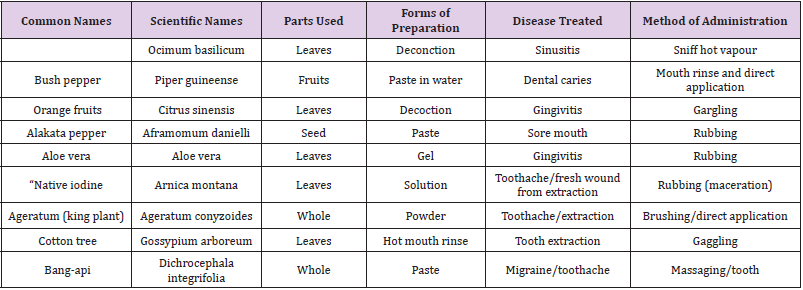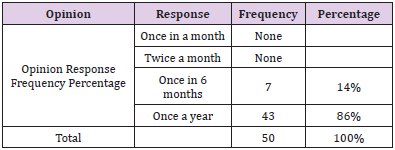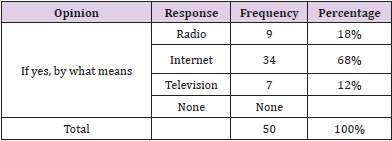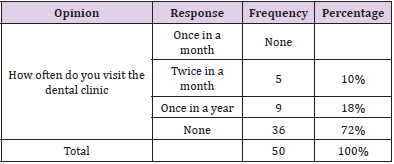Abstract
Local herbs contain antibiotic and anti-inflammatory constituents for treatment of certain diseases. The use of local herbs is dated back to many decades most especially in African countries. The 10 different oral conditions (toothache/decay, gingivitis, ulcerative gingivitis, angular stomatitis, mouth ulcers, swollen tonsil, oral thrush, tonsillitis, and black tongue) treatable with plants in traditional health practice documented in the literature were also noted in this study except for black tongue. The objective of this study is to investigate the effect of local herbs on children’s oral health in Ado Ekiti. Fifty questionnaires were randomly distributed among parents in the study area. Data were collected and analyzed in percentage and graphical representations. It was concluded that local herbs have varied effects on oral health of children in the study area. It was therefore recommended that Health Educationist should enlighten the producer of local herb to scientifically demonstrate the real effects of natural medicine, as well as clarify and establish their possible therapeutic applications while parents should discourage the use of prescribed drugs in form of local herbs.
Keywords: Herbs; Oral Health; Gingivitis; Dental Caries
Introduction
Local herbs are used for treatment of some certain diseases and they come in different formulations such as leaves flowers, stems, roots, seeds, and berries. It can be used in from of pills or powders, dissolved into tinctures or syrups, or brewed in teas and decoctions [1]. Many children battle dental health problems due to the use of medicinal plants which causes toothache, pulp necrosis, brownish teeth and mummification of the pulp tissue [2]. However, these dental health conditions are temporary because further dental caries leads to reinfection of dental pulp tissues and consequent reoccurrence of pain. The 10 different oral conditions (toothache/ decay, gingivitis, ulcerative gingivitis, angular stomatitis, mouth ulcers, swollen tonsil, oral thrush, tonsillitis, and black tongue) treatable with plants in traditional health practice [3] documented in the literature were also noted in this study except for black tongue. However, other additional uses like oral syphilis, oral cancer, tooth bleaching, halitosis, and dental extraction reported in this study reflect the comprehensive and nationwide spread of the study. These local herbs are also used in the treatment of diseases and food preservation which includes Canarium schweinfurthii, Vernonia amygdalina, Anacardium occidentale, Cocos nucifera, Allium sativum, Citrus sinensis, Carica papaya, Allium cepa, Ricinodendron heudelotii, Mangifera indica, Zea maize, and Syzygium aromaticum [4]. This is in line with other studies carried out by [5,6]. who found out that some of these plants and their parts such as roots, rhizomes, tubers, leaves, stem, wood, bark, flowers, seeds, and fruits are used in various purposes in their daily life?
Effect of Local Herb on Children Oral Health
Study has shown that local herbs possess both positive and negative effects on children’s oral health. In fact, some children have been exposed to local herbs right from their mothers’ wombs due to certain herbs taken by mothers during pregnancy as remedy to some health conditions [7].
Negative Effect of Local Herb in Children Oral Health
Study have shown that children develop infections, seizures and convulsions from herbal drugs and local herbs [8-10]. Its tolling effect on their dental health is alarming. Since the mouth is the gateway to the body and other essential organs, it is only noteworthy that children may respond to infections due to their small body weight and immature gastrointestinal, nervous, and immune systems [11-16]. The use of some local herb can give permanent teeth a yellowish or brownish colour [17-19].
Possible Effects
a) Excessive amounts of local herb containing fluoride can cause white or discoloured spots to form on developing permanent teeth. This is called fluorosis. Young children who routinely take fluoridated medicinal herb are at increased risk [9].
b) Many local herbs reduce the flow of saliva and cause a condition called ‘dry mouth syndrome’. Dry mouth significantly increases the risk of tooth decay and Halitosis.
c) There can be interactions between local herb and drugs which are prescribed for children.
Objectives
a) To find out the effects of local herbs on the oral health of children in Ado Ekiti
b) To know whether local herbs are used for disease treatment in the study area.
Methodology
The researcher made use of descriptive design method with fifty of our respondents selected for this study using simple random sampling technique. The research instrument used for data collection includes questionnaire, personal interview and observation Tables 1-3. The fifty copies of questionnaire were randomly distributed to the parents living at Omisanjana, Ado Ekiti, Ekiti State. The statistical tools utilized were simple percentage and frequency distribution.
Table 3: The Minerals Used as Adjunct Were Calcium Carbonate, Alum, Bicarbonate Solution, And White And Yellow Sulphur.
Result
Background Information About the Respondents (Tables 4-8)
Discussion of findings
Table 4 showed that 19 respondents representing 38% are of age 18-25years, 21 respondents representing 42% are of age 26-35years and 10 respondents representing 20% are of age 36 years and above. Table 5 showed that 34 respondents representing 68% are female while 16 respondents representing 32% are male. Table 6 and Table 7. Attitudes, Knowledge and Awareness of the children Towards Taking of local herb and Role of Health Educationists. It was revealed that 39 respondents representing 78% have heard about local herb before while 11 respondents representing 22% are not aware what local herb is. It was also gathered that 8 respondents representing 16% take herb at least every 6month while 42 respondents representing 84% take herb at least once in a year. 26% have used local herb for oral problem while 37 respondents representing 74% did not use local herb for oral problem Table 8 and Table 9. 44% said local herb have positive effect on their body while 28 respondents representing 56% said it is a negative effect on their body. It was gathered that 17 respondents representing 34% said the local herb works for what it was used for while 33 respondents representing 66% said it does not work for what it was used for Tables 10-14. 45 respondents representing 90% said they have enlightened by a health educationist about local herb while 5 respondents representing 10%, said they haven’t been enlighten by an health educationist. 37 respondents representing 74% have visited the dental clinic for oral care while 13 respondents representing 26% did not visit the dental clinic before. 5 respondents representing 10% do visit the clinic twice a year, 9 respondents representing 18% do visit the clinic once in a year, 36 respondents representing 72% never visit the dental clinic.
Table 7: Attitudes, Knowledge and Awareness of the children Towards Taking of local herb and Role of Health Educationists.
39 respondents representing 78% have seen a friend with stain in the teeth while 11 respondents representing 22% have not seen a friend with stain in the teeth. 14 respondents representing 28% have seen an oral problem cure by local herb while 36 respondents representing 72% have not seen any oral problem cure by local herb. 76% said there is a local herb that can cure for Tooth pain, 4% said there is a cure for mouth odour, 20% said there is a cure for tooth Decay. 84% said they will advise their Friends to visit the clinic for treatment of tooth pain, 10% said they will advise their Friends to use self-Medication, 6% said they will advise their friends to use local herb Tables 15-19.
Conclusion
It was therefore concluded that local herbs have varied effect on oral health of children in the study area. There is evidence of usage of herbal medicines of different formulations as confirmed by respondents while some believed herbal medicine has no negative effect on oral health of children, majority believed dental health problems such as brownish teeth, gingivitis etc. are due to uncontrolled use of local herbs.
Recommendations
a) Parents should not equate “natural” with “safe.”
b) Parents should seek expert guidance on the use of local herbs if need be.
c) Parent should discourage self-medication due to toxicity of certain plants.
d) Unlike drugs, herbal products have not been scrutinized by NAFDAC, so it is truly a case of “buyer-beware.” Hence, public awareness should be given to prevent the abse of herbal medicine.
e) Government should deploy Health Educationist to ensure home visitation in enlighten children and parents on the usage of local herb for oral care.
f) Government should regulate producer of local herb to scientifically demonstrate the real effects of natural medicine, as well as clarify and establish their possible therapeutic applications.
g) Local herbs should be analysed to evaluate their effectiveness as possible pharmaceutical sources and/or support their use for oral care as treatments.
Conflict of interest
There is no conflict of interest to declare.
References
- Anushri M, yasoda R, puranik MP (2015) Herbs: A good alternative to current treatment of oral health.
- Sinha DJ, Sinha AA (2014) Natural medicaments in dentistry. 35(2): 113-118.
- Sinha A, Bhardwaj SV (2012) Role of medicinal herb in prevention and treatment of dental disease. 1(3): 95-101.
- Rloss JL, Racio MC (2005) Medical plant and antimicrobial activities. 100(1-2): 80-84.
- Miller LG (1998) Herbal medicinal: Selected clinical consideration focusing on known or potential drug-herb interaction. 158(20): 2200-2211.
- Little JW (2004) Complementary and alternative medicine: Impact on dentistry, oral surgery, oral medicine, oral pathology. Medical Management Update 98(2): 137-145.
- D Auria FD, Tecca M, Scazzocchio F, Renzini V, Strippoli V, et al. (1994) Herbal drugs and phytopharmaceutical. (2003). Effect of propolis on virulence, factor of candida albicans. 15(5): 454-460.
- Jain N, Rajwar YC, Batra M, Singh HP Bhandari R, Agarwal P, et al. (2014) Dentistry turning toward Herbal alternatives. Sch. J App Med Sci 2(1C): 253-257.
- Shivayogi Charantimath, Rakesh oswal (2011) Herbal therapy in dentistry.
- I nite-kang LL, linfongo LM, mbaze, Nnange Ekwelle, Luc C Owono Owono, et al. (2013) Cameroonian medical plants a bioactivity versus ethnobotanical survey and chemotaxonic classification.
- SD Dibong, E mpondo mpondo A Ngoye, R J prso (2011) Inventory and biodiversity of species edible wild fruits sold in the market of douala, Cameroon.
- N Din, E Mpondo mpondo, SD Dibong, NI Kwin, A Ngoye, et al. (2011) Inventory and identification of plants used in treatment of diabetes in douala town (Cameroon). European Journal of Medicinal Plants 1(3): 60-73.
- Fatovich DM (1992) Aconite A lethal Chinese herb. 21(3): 309-311.
- Med Lett Drugs (1979) Toxic reaction to plant product sold in health food stores.
- Bennner MH, Lee HJ (1973) Anaphylactic reaction to chamomile tea. 52(5): 307-308.
- Roulet M, launi R, River L, Calamie A (1988) Hepatic veno-occlussive disease in newborn infant of a woman drinking Herbal tea. Clinical and laboratory observation 112(3): 433-436.
- Pages N, Salazar M, Chamoro G (1988) Teratological evaluation plectra thus fruiticosus leaft essential oil.
- Rosenberg DM (1997) advising patient who seek alternative medical therapies. Annals of Internal Medicine 127: 61-69.
- Ang-Lee MK, Moss J, Yuan C S (2001) Herbal medicine and preoperative care. JAMA 286(2): 208-216.

 Research Article
Research Article


















